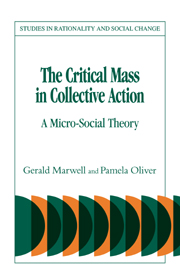Book contents
- Frontmatter
- Contents
- PREFACE
- ACKNOWLEDGMENTS
- 1 The critical mass and the problem of collective action
- 2 Building blocks: goods, groups, and processes
- 3 The paradox of group size
- 4 The dynamics of production functions
- 5 Social networks: density, centralization, and cliques
- 6 Selectivity in social networks
- 7 Reach and selectivity as strategies of recruitment
- 8 Unfinished business
- REFERENCES
- NAME INDEX
- SUBJECT INDEX
5 - Social networks: density, centralization, and cliques
Published online by Cambridge University Press: 19 March 2010
- Frontmatter
- Contents
- PREFACE
- ACKNOWLEDGMENTS
- 1 The critical mass and the problem of collective action
- 2 Building blocks: goods, groups, and processes
- 3 The paradox of group size
- 4 The dynamics of production functions
- 5 Social networks: density, centralization, and cliques
- 6 Selectivity in social networks
- 7 Reach and selectivity as strategies of recruitment
- 8 Unfinished business
- REFERENCES
- NAME INDEX
- SUBJECT INDEX
Summary
Our discussions so far have ignored the problem of how collective action might be coordinated. We have mostly assumed that individuals contribute independently without coordination, although with knowledge of others' actions. In a few cases, we have shown how simultaneous coordinated actions would affect individuals' decisions, but without inquiring into the ways in which such coordination might be achieved. In this chapter, we introduce an explicit model for this coordination and then examine the effects of different features of social networks on the prospects for coordinated action.
The core of our model of simultaneous coordinated action is the assumption that there is a single organizer who contacts all possible actors and absorbs all the costs of organizing the action. The simultaneous coordinated action is modeled as an all-or-none contract. The organizer is conceived as asking others to participate in a risk-free agreement to make contributions if enough others also agree. As described briefly in Chapter 4, group members will agree to contribute if the total benefit they would experience from the “contract” exceeds their own share of the cost. Our single organizer is usually thought of as one person, but the model would also apply to any small group whose members have decided to pool their resources and act in concert, as if they were one complex person. We have repeatedly stressed that there is no single general process of collective action, but rather kinds of actions. We make no claim that all collective actions are organizer-centered or can be approximated by the organizercentered model.
- Type
- Chapter
- Information
- The Critical Mass in Collective Action , pp. 101 - 129Publisher: Cambridge University PressPrint publication year: 1993

